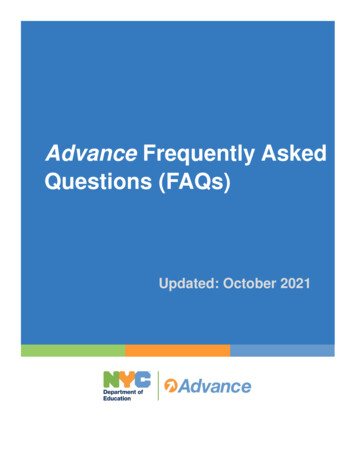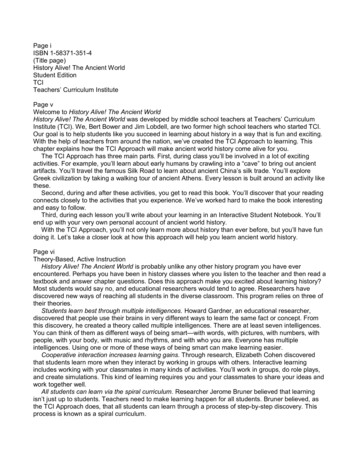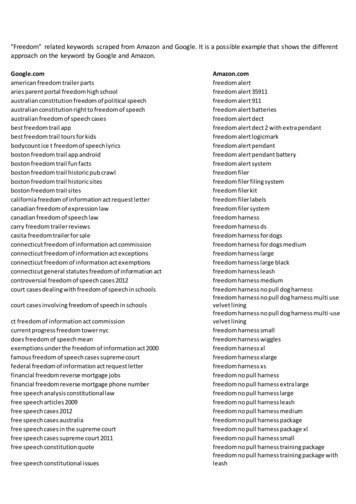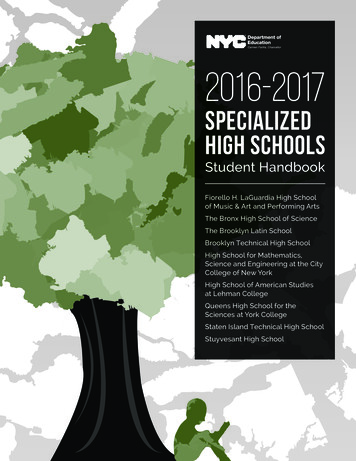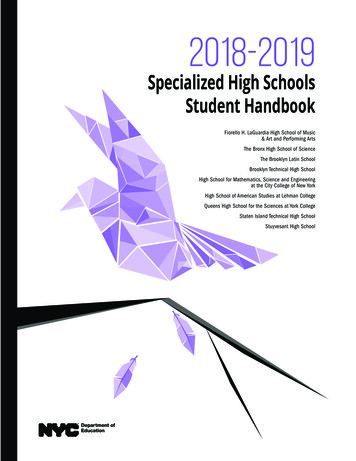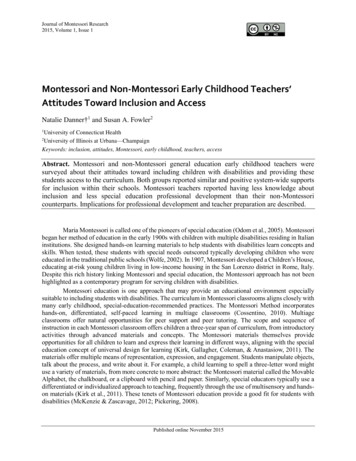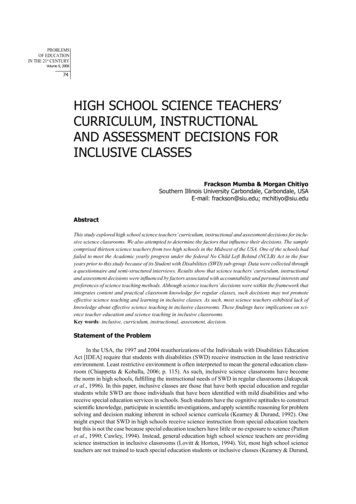
Transcription
PROBLEMSOF EDUCATIONIN THE 21st CENTURYVolume 9, 200874HIGH SCHOOL SCIENCE TEACHERS’CURRICULUM, INSTRUCTIONALAND ASSESSMENT DECISIONS FORINCLUSIVE CLASSESFrackson Mumba & Morgan ChitiyoSouthern Illinois University Carbondale, Carbondale, USAE-mail: frackson@siu.edu; mchitiyo@siu.eduAbstractThis study explored high school science teachers’ curriculum, instructional and assessment decisions for inclusive science classrooms. We also attempted to determine the factors that influence their decisions. The samplecomprised thirteen science teachers from two high schools in the Midwest of the USA. One of the schools hadfailed to meet the Academic yearly progress under the federal No Child Left Behind (NCLB) Act in the fouryears prior to this study because of its Student with Disabilities (SWD) sub-group. Data were collected througha questionnaire and semi-structured interviews. Results show that science teachers’ curriculum, instructionaland assessment decisions were influenced by factors associated with accountability and personal interests andpreferences of science teaching methods. Although science teachers’ decisions were within the framework thatintegrates content and practical classroom knowledge for regular classes, such decisions may not promoteeffective science teaching and learning in inclusive classes. As such, most science teachers exhibited lack ofknowledge about effective science teaching in inclusive classrooms. These findings have implications on science teacher education and science teaching in inclusive classrooms.Key words: inclusive, curriculum, instructional, assessment, decision.Statement of the ProblemIn the USA, the 1997 and 2004 reauthorizations of the Individuals with Disabilities EducationAct [IDEA] require that students with disabilities (SWD) receive instruction in the least restrictiveenvironment. Least restrictive environment is often interpreted to mean the general education classroom (Chiappetta & Koballa, 2006; p. 115). As such, inclusive science classrooms have becomethe norm in high schools, fulfilling the instructional needs of SWD in regular classrooms (Jakupcaket al., 1996). In this paper, inclusive classes are those that have both special education and regularstudents while SWD are those individuals that have been identified with mild disabilities and whoreceive special education services in schools. Such students have the cognitive aptitudes to constructscientific knowledge, participate in scientific investigations, and apply scientific reasoning for problemsolving and decision making inherent in school science curricula (Kearney & Durand, 1992). Onemight expect that SWD in high schools receive science instruction from special education teachersbut this is not the case because special education teachers have little or no exposure to science (Pattonet al., 1990; Cawley, 1994). Instead, general education high school science teachers are providingscience instruction in inclusive classrooms (Lovitt & Horton, 1994). Yet, most high school scienceteachers are not trained to teach special education students or inclusive classes (Kearney & Durand,
Frackson MUMBA, Morgan CHITIYO. High School Science Teachers’ Curriculum, Instructional and Assessment Decisions for Inclusive ClassesPROBLEMSOF EDUCATIONIN THE 21st CENTURYVolume 9, 20081992; Norman et al., 1998; Pyle & Butera, 1997). As such, special education and science educators 75have raised doubt on whether high school science teachers can effectively execute their new role asinclusive classroom teachers since they have not received training for inclusive classrooms (Kearney& Durand, 1992; Mcintosh et al., 1993; Normal et al., 1998; Robinson, 2002). In their new role ascourse designers and instructors for inclusive classes, high school science teachers must make curriculum and instructional decisions that can promote effective science teaching and learning in suchsettings (Mastropieri & Scruggs, 1994). They must also make decisions on assessment criteria thatare effective for such settings. However, research on inclusion shows that most high school scienceteachers are generally not sensitive to individual needs and are unlikely to make adjustments in theirteaching materials or instructional strategies for SWD (Cawley et al., 1998). Therefore, the successof providing quality science instruction to all students through inclusion in high schools will largelydepend on general education high school science teachers’ curriculum, instructional and assessmentdecisions for inclusive classes and the factors that influence such decisions. Success is also likelyto depend on science teachers’ knowledge about SWD and their willingness to accommodate themin science lessons. In order to start addressing this educational problem, this study explored generaleducation high school science teachers’ curriculum, instructional and assessment decisions for inclusive classrooms. We also attempted to determine the factors that influenced their decisions.Several studies have emphasized the importance of exploring science teachers’ decisions andfactors that influence such decisions because they form an ideal base for developing training andsupport programs (Duschl & Wright, 1989; Sanchez & Valcarcel, 1999; Bell & Lederman, 2003). Theunderlying assumptions on teacher decision making research are twofold: first, teachers are professionals who make reasonable judgments and decisions within school and classroom environments;and second, teachers’ judgments and decisions guide their classroom behavior (Calderhead, 1984).As such, several studies have reported science teachers’ curriculum and instructional decisions andfactors that influence such decisions for general education classrooms. When teachers make instructional decisions they consider information about student attributes, content, goals and objectives,and outcomes (Shavelson & Stern, 1981; Clark & Peterson, 1986). Factors such as the physical andorganizational characteristics of the school and classrooms; teacher’s practical knowledge, their beliefsabout teaching, and attitude towards subject content and pedagogy also influence teacher decisionmaking (Sanchez & Valcarcel, 1999). Other studies show that teachers’ curriculum and instructionaldecisions are based on personal values, beliefs, internal and external circumstances, as well aswhat happens while the instruction is taking place (Klimczak et al.1995). However, a comparableknowledge base on science teachers’ curriculum, instructional and assessment decisions for inclusiveclassrooms and the factors that influence their decisions doesn’t exist. Yet, such a knowledge baseis essential for teacher preparation and support programs for effective science teaching in inclusiveclassrooms. Therefore, the findings of this study are of particular interest to both science and specialeducation communities and teacher professional development providers who wish to understand howgeneral education high school science teachers decide on the curriculum, instructional strategies andassessment criteria for inclusive classrooms. However, this study focused on one particular area ofteacher decision making- specifically, pre-active instructional decisions. Pre-active decisions referto the choices teachers make as they plan for teaching and reflect on their teaching.Methodology of ResearchThis study was conducted in two local high schools located in two Mid western towns of theUSA. One school is located in a town of 28,000 people while the other one is in a smaller town of1300 people. The sample for this study comprised thirteen high school science teachers in the twolocal public high schools. Ten of the participants were female while three were male. There wereseven biology, three chemistry and three physics teachers. The average age of the participants was37 years and their teaching experience ranged from 7 to 16 years. None of the teachers had receivedtraining in special education either in their pre-service teacher education program or through a teacherprofessional development program. These teachers taught grades 10-12 general science and AdvancedPlacement (AP) chemistry, biology and physics classes. Only two biology teachers co-taught biology courses with special education teachers. Both schools had resource rooms where SWD received
PROBLEMSOF EDUCATIONIN THE 21st CENTURYVolume 9, 200876extra help from special education teachers. The average class size in each school was 21 students.The range of SWD in inclusive classes was 7-10. Disabilities among SWD were Attention-DeficitHyperactivity Disorder (ADHD), sensory disabilities (hearing loss and visual impairment), learningand physical disabilities.Data were collected through a questionnaire and semi-structured interviews. The questionnaire was categorized into four sections: section one included background information about theparticipants’ teaching experience, teaching specialization and training in special education; sectiontwo focused on the curriculum decisions to ascertain how teachers plan lessons and student activitiesfor an inclusive classroom; section three focused on instructional decisions teachers made; and section four focused on the assessment strategies teachers used. After the questionnaires were analyzedteachers were interviewed to allow them to elaborate on their questionnaire responses. The averageduration of the interviews was 30 minutes. Sample questions for the interviews were (a) how do youdecide on what science content/topic to teach in your inclusive classes? (b) What teaching methodsdo you use to teach science in inclusive classes? (c) What assessment strategies do you use to assessstudents in inclusive classrooms?Data were analyzed using a constant comparative method (Strauss & Corbin, 1998). The procedure involved reading (and re-reading) responses in the questionnaires and interview transcripts.Essentially, each line, sentence, and paragraph in the data sources was read in search of the answerto these two questions: What is this about? What is being referenced here?” Then the participants’responses were open-coded to identify recurring themes. Thereafter, categories were generated throughcomparing the themes for similarities and differences; these provided the representative profiles ofthe group being studied. The authors conducted the initial stages of data analysis using this procedureindependently. Following each stage they met to discuss the results and resolve any differences in thethemes and categorization. However, they collaborated on the last stage of analysis and the final setof categories was a result of this process. Teachers’ decisions on curriculum, instruction, assessmentand factors that influenced such decisions represented the content categories.Results of ResearchCurriculum decisions: Both questionnaire and interview responses showed that science teachers did not have individualized curriculum for SWD. Instead, they had lessons and units designedfor all students in their inclusive classes. This is in keeping with the finding reported by Cawley etal. (1998) that SWD are treated by general education science teachers much like other students. Toa large extent science teachers’ decisions on what to teach in inclusive classes were influenced bymandatory Standardized testing. SWD as well as those without disabilities were expected to passmandatory standardized tests; otherwise the school will be placed on academic watch list by the Stateand Federal government. There was a prevailing belief among the teachers that since the desiredlearning outcomes were identical for all students, then they should all experience the same sciencecontent knowledge and science processes skills to enable each student to achieve the outcomes.Other factors that influenced teachers’ decisions on the curriculum were curriculum guides fromschool districts, National and State Science learning Standards, textbooks, available lab materials,and personal interests and preferences. For example Jane, a chemistry teacher said:I decide on the content for my courses based on curriculum guides from our schooldistrict, textbook, learning standards, standardized tests and what I think is good formy students beyond high school It is difficult to include all the things especially withspecial education students in class (Jane, Chemistry teacher).Similarly, Jim a Biology teacher in another school said:Standards and curriculum guides are key factors in my decision on what to teach at eachgrade level. I also have some personal preference regarding emphasis on certain topics(Jim, Biology teacher).Both Jane and Jim relied on the prescribed curriculum materials from school districts which they
Frackson MUMBA, Morgan CHITIYO. High School Science Teachers’ Curriculum, Instructional and Assessment Decisions for Inclusive ClassesPROBLEMSOF EDUCATIONIN THE 21st CENTURYVolume 9, 2008believe were aligned with standardized tests. As such, many teachers decided to use these teaching 77materials to help their students learn and pass science tests.Science teachers also said they begin by thinking of the content to be taught as outlined intextbooks and then choose activities for the lessons. For this, a textbook was the principal source ofactivities. Teachers justified using the textbooks because they themselves chose them and in theiropinions, the textbooks were thorough and contained the basic necessary information. The use ofcurriculum guides and textbooks supports the previous finding which states that when teachers maketheir decisions on curriculum they rely on curriculum guidelines from their districts for accountabilitypurposes (Duschl & Wright, 1989; Sanchez & Valcarcel, 1999).When asked about the SWD, most teachers said they did not take them into account whendeciding on the content to teach in their inclusive classes. As such, SWD’s influence on teachers’decisions on curriculum was not significant. The curriculum guidelines from the school districtsand standardized tests seemed to have outweighed the SWD in teacher decisions on curriculum forinclusive science classes.Most science teachers also noted that their teaching experience and training played a vital roleregarding their decisions on what and how to teach science in inclusive classes. This finding andthose stated above support previous studies which reported that teachers make decisions withina framework that takes into account science content, and practical classroom knowledge whichincludes teachers’ beliefs coupled with their experience (Aikenhead, 1984; Sanchez & Valcarcel,1999; Mumba et al., 2007).Instructional decisions: Questionnaire and interview responses showed that science teachersreported using multiple teaching and learning strategies for all students. In particular, teachers’ instructional decisions encompassed several teaching methods such as visual and audio aids, flash cards,hands on activities, lecture, group work, discussion and demonstration. Their instructional decisionswere influenced by many factors such as content to be taught, teaching experience, standardizedtests, available resources, time, experience, suggestions from peers, available resources, students’abilities, personal interests, and student deficit and attention span. However, some teachers said thatthey experienced some difficulties such as insufficient time, frequent interruption, academic and behavioral problems in their classes. Only four science teachers out of thirteen teacher said they madespecial accommodation for SWD such as seating accommodations, and use of microphones duringlessons when required. For example Karen, a physics teacher gave one example in her questionnaireresponses on how she accommodated SWD.I have a number of students with hearing problems in my classes. So I use a microphonein my classes to help them hear me. But it is difficult for them to hear other studentswho give an answer off the microphone. I also ask them to seat in front row and not atthe back (Karen, Physics teacher).Although Karen and other three teachers wrote in the questionnaire that they helped SWDthrough special accommodation, it was evident in the interviews that it is very difficult for them toaccommodate all SWD because of the different learning needs among SWD. As such, most teachersreferred SWD to resource room teachers for extra help.Assessment decisions: Each of the science teacher’s decisions on assessment was guided bya belief that all students including SWD must be assessed in the same way to help them preparefor standardized tests. Generally, assessment strategies employed by this group of science teacherstook the form of asking students questions and written tests such as multiple choice questions, quizzes and fill in the blank. Sanchez & Valcarcel, (1999) also found that teachers rely on written teststo assess their students. The factors that influenced teachers’ decisions on assessment were Statestandardized tests, teaching experience, grade level, time, and content. Although special educationstudents were given longer time to take the tests, they took the same tests and were graded in thesame way as regular students.
PROBLEMSOF EDUCATIONIN THE 21st CENTURYVolume 9, 200878DiscussionThe purpose of this study was to explore high school science teachers’ curriculum, instructionaland assessment decisions for inclusive science classrooms and the factors that influenced their decisions. The results show that the general education high school science teachers made decisionson curriculum, instruction and assessment for their inclusive classes based on the factors that weremainly associated with accountability at the school and State levels. The results also show that science teachers’ decisions were within the framework that integrates content and practical classroomknowledge for regular classrooms and not for inclusive classroom. The practical classroom knowledgeincluded their beliefs about science teaching in regular classrooms. To a large extent these results arein keeping with research findings on inclusion that most high school science teachers are generallynot sensitive to individual needs and are unlikely to make adjustments in their teaching materialsand teaching strategies for SWD (Cawley et al., 1998). Research also shows that science teachers’practical knowledge mostly comprises their images of basic beliefs of science teaching in regularclassrooms (Aikenhead, 1984; Norman et al., 1998; Bell, & Lederman, 2003). Unfortunately, suchteacher decisions may not promote effective science teaching and learning in inclusive classrooms.These findings also support the assertion that most teachers lack pedagogical knowledge for effective science teaching in inclusive classrooms (Vaughn, & Schumm, 1994). In addition, the resultsreveal how far the ideas of the science teachers were from the inclusion science teaching which isalso aimed at achieving scientific literacy among all students. Scientific literacy for all students isthe central theme of current USA science education reforms (American Association for the Advancement of Science [AAAS], 1993) and science education standards (National Research Council [NRC],1996). We attribute this problem to general education science teachers’ lack of training in specialeducation. For this reason, given the nature of this educational problem, we encourage that scienceteacher education programs should be aware that many science teachers teach science to a mixtureof special education and regular students. Therefore, it is necessary that science teacher educationprograms should provide special education training to pre-service teachers for them to effectivelyteach science to both regular students and SWD.Based on the findings in this study and previous studies there is need for the in-service scienceteachers to change their existing pre-active decision making process to one that takes the learningneeds of SWD into account. However, such a change requires new experience among teachersthrough a professional development on science teaching in inclusive classrooms (Kearney & Durand,1992; Robinson, 2002; Kirch et al., 2005). Such changes will also require orientation regarding thecurriculum design and pedagogical training for inclusive classrooms. This orientation should belinked with concrete models and theories that underlie inclusion. For the proposed changes to be putinto practice, high school science teachers will have to see the sense and usefulness for their newlyobtained knowledge and pedagogical skills. Otherwise, science teachers will not be able to addressthe needs of all students in inclusive classrooms.There was also limited availability of special education teachers in the two school who couldassist with teaching and curriculum modifications. Only two of the thirteen teachers co-taught withspecial education teachers. As such, many science teachers did not comply with the accommodationslisted on students’ individualized education plans (IEPs). Lucid deliberations between science teachers and special education teachers would help science teachers learn more about SWD and teachingstrategies for inclusive classrooms (Pyle et al., 1999); that is, deliberations may help science teachersto start thinking about SWD when they plan instructional activities for inclusive classrooms.This study only focused on science teachers’ decisions for inclusive classrooms at pre-activeinstructional phase and the factors that influenced their decisions. Future studies should focus onscience teachers’ decisions during active and post-active instructional phases to better understandtheir decision making process for inclusive classes.
Frackson MUMBA, Morgan CHITIYO. High School Science Teachers’ Curriculum, Instructional and Assessment Decisions for Inclusive ClassesPROBLEMSOF EDUCATIONIN THE 21st CENTURYVolume 9, 2008ConclusionsThe factors that influenced high school science teachers’ decisions on curriculum, instructionand assessment for their inclusive classes were those that are mainly associated with accountabilityin education system. Science teachers’ decisions on how to teach science in inclusive classroomswere influenced by their beliefs about effective science teaching for regular classes. Therefore, itcan be concluded that science teachers’ pre-active decisions served two functions: accountabilityin the school system and personal interest and preferences of science teaching strategies. It is alsoconcluded that science teachers’ decisions were within the framework that integrates content andpractical classroom knowledge for regular classrooms and not for inclusive classroom. Unfortunately,such decisions are not consistent with effective teaching and learning strategies for inclusive classrooms. As such, the high school science teachers, in this study, exhibited lack of knowledge abouteffective science teaching in inclusive classrooms.ReferencesAmerican Association for the Advancement of Science [AAAS] (1993). Benchmarks for Science Literacy: AProject 2061 Report, New York: Oxford University Press.Aikenhead, G. S. (1984). Teacher decision making: the case of Prairie High. Journalof Research in Science Teaching, 21(2); 167-186.Bell, R. L., & Lederman, N. G. (2003). Understandings of the Nature of Science and Decision Making onScience and Technology Based Issues. Science Education, 87(3), 352.Calderhead, J. (1984). Teachers’ classroom decision making: London: Holt, Rinehart and Winston.Cawley, J. F. (1994). Science for students with disabilities. Remedial and SpecialEducation, 15, 67-71.Cawley, J. F., Kahn, H., & Tedesco, A. (1998). Vocational education and studentswith learning disabilities. Journal of learning Disabilities, 22, 630-634.Chiappetta, E. L & Koballa, T. R. (2006). Science instruction in the middle and secondary schools. Developingfundamental knowledge and skills for teaching. Sixth Edition. Columbus, OH; Merrill Prentice Hall.Clark, C. M., & Peterson, P.L. (1986). Teachers’ thought processes. In M.C. Wittrock (Ed). Handbook ofresearch on teaching (pp. 255-296).Duschl, R. A., & Wright, E. (1989). A case study of high school teachers’ decision making models for planning and teaching science. Journal of Research in Science Teaching, 26, 467-501.Jakupcak, Z., Rushton, R., Jakupcak, M & Lundt, J. (1996). Inclusive Education. The Science Teacher, 40(5),40-43.Kearney, C. A., & Durand, V. M. (1992). How prepared are our teachers for mainstream classroom settings?A survey of postsecondary schools of education in New York State. Exceptional Children, 59, 6-11.Kirch, S. A., Bargerhuff, M. E., Turner, H., & Wheatly, M. (2005). Inclusive Science Education: ClassroomTeacher and Science Educator Experiences in CLASS Workshops. School Science & Mathematics, 105(4),175-196.Klimczak, A. K., & Balli, S. J. (1995). Teacher decision making regarding content structure: A study. Journalof Instructional Psychology, 22(4), 330.Individuals with Disabilities Education Act [IDEA] (1997). Retrieved on Oct 10, 2008 http://www.cec.sped.org/law res/doc/law/downloads/Idea97.docLovitt, T. C., & Horton, S. V. (1994). Strategies for adapting science textbooks for youths with learning disabilities. Remedial and Special Education, 15, 105-116.Mastropieri, M. A., & Scruggs, T. E. (1994). Text versus hands-on science curriculum. Remedial and SpecialEducation, 15(2), 72.Mcintosh, R., Vaughn, S., Shumm, J.S., Haager, D., & Lee, O. (1993). Observations of students with learning79
PROBLEMSOF EDUCATIONIN THE 21st CENTURYVolume 9, 200880disabilities in general education classrooms. Exceptional Children, 60, 249-261Mumba, F. Chabalengula, V.M., Moore, C., & Hunter, W. (2007). Mathematics and science teaching fellows’instructional planning for K-12 classrooms. Science Educator, 16(2), 38-43.National Research Council [NRC] (1996,). National Science Education Standards. Washington, DC. NationalAcademic Press.Norman, K., Caseau, D. & Stefanich, D. P. (1998). Teaching students with disabilities in inclusive scienceclassroom: Survey results. Science Education, 82, 127-146Pyle, E. J., & Butera, G. (1997). Perspectives on inclusion by design: Science curriculum reform and specialeducation. Information Technology and Disabilities, 4(4), (www.isc.rit.edu/ easi/it/itv04n4/article4.html).Pyle, E. J., Butera, G., & McMullen, L. (1999). Science inclusion in a climate of reform (SICOR). (Eric Document Reproduction Service No. ED 443662).Patton, J., Polloway, E., & Cronin, M. (1990). A survey of special education teachers relative to science forthe handicapped. Unpublished manuscript. University of Hawaii, Honolulu.Robinson, S (2002). Teaching high school students with learning and emotional disabilities in inclusion science classrooms: A case study of four teachers’ beliefs and practices. Journal of Science Teacher Education,13(1), 13-26.Sanchez, G., & Valcarcel, V. M. (1999). Science teachers’ views and practices in planning for teaching. Journalof Research in Science Teaching, 36(4), 493-513.Shavelson, R. J., & Stern, P. (1981). Research on teachers’ pedagogical thoughts, judgments, decisions andbehavior. Review of Educational Research, 51; 455-498.Strauss, A. & Corbin, J. (1998). Basics of Qualitative Research: Techniques and Procedures for developingGrounded Theory, 2nd Ed. Newbury Park, CA: Sage Publications.Vaughn, S., & Schumm, J. S. (1994). Middle school teachers’ planning for students with learning disabilities.Remedial and Special Education, 15(3), 152.Adviced by William Hunter,Illinois State University, Normal, IL USAFrackson MumbaMorgan ChitiyoAssistant Professor of Science Education, Department of Curriculum andInstruction, Southern Illinois University Carbondale, Illinois 62901-4610, USA.E-mail: frackson@siu.eduWebsite: http://www.siu.eduAssistant Professor of Special Education, Department of Education Psychologyand Special Education, Southern Illinois University Carbondale, Illinois 62901-4618,USAE-mail: mchitiyo@siu.eduWebsite: http://www.siu.edu/departments/coe/epse
E-mail: frackson@siu.edu; mchitiyo@siu.edu Abstract This study explored high school science teachers' curriculum, instructional and assessment decisions for inclu- . Teachers' decisions on curriculum, instruction, assessment and factors that infl uenced such decisions represented the content categories. Results of Research

